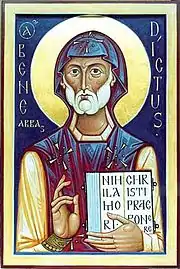
Benedict of Nursia OSB (Latin: Benedictus Nursiae; Italian: Benedetto da Norcia; 2 March AD 480 – 21 March AD 547), often known as Saint Benedict, was an Italian Christian monk, writer, and theologian. He is venerated in the Catholic Church, the Eastern Orthodox Church, the Oriental Orthodox Churches, the Anglican Communion, and Old Catholic Churches. In 1964 Pope Paul VI declared Benedict a patron saint of Europe.
Benedict founded twelve communities for monks at Subiaco in present-day Lazio, Italy (about 65 kilometres (40 mi) to the east of Rome), before moving further south-east to Monte Cassino in the mountains of central Italy. The present-day Order of Saint Benedict emerged later and, moreover, is not an "order" as the term is commonly understood, but a confederation of autonomous congregations. (Full article...)
Attributes: Bell, broken tray, broken cup and serpent representing poison, broken utensil, bush, crosier, man in a Benedictine cowl holding Benedict's rule or a rod of discipline, raven
Patronage: Against poison, against witchcraft, agricultural workers, cavers, civil engineers, coppersmiths, dying people, erysipelas, Europe, farmers, fever, gall stones; Heerdt, Germany; heraldry and Officers of arms; Institute of Christ the King Sovereign Priest; inflammatory diseases; Italian architects; kidney disease; monks, nettle rash; Norcia, Italy; people in religious orders; San Beda University; schoolchildren and students; servants who have broken their master's belongings; speleologists; spelunkers; temptations